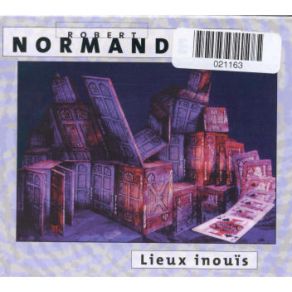Lieux Inouis
Download links and information about Lieux Inouis by Robert Normandeau. This album was released in 1999 and it belongs to Rock genres. It contains 5 tracks with total duration of 01:13:54 minutes.

|
|
|---|---|
| Artist: | Robert Normandeau |
| Release date: | 1999 |
| Genre: | Rock |
| Tracks: | 5 |
| Duration: | 01:13:54 |
| Buy it NOW at: | |
| Buy on iTunes $9.99 | |
| Buy on Amazon $8.99 | |
Tracks
[Edit]| No. | Title | Length |
|---|---|---|
| 1. | Jeu(1989) | 24:07 |
| 2. | Memoires Vives(1989) | 16:02 |
| 3. | Rumeurs(Place De Ransbeck)(1987) | 12:26 |
| 4. | Matrechka(1986) | 14:00 |
| 5. | Le Cap De La Tourmente(1985) | 7:19 |
Details
[Edit]Robert Normandeau's releases Tangram (1994) and Figures (1999) have established him as one of the leading exponents of musique concrète in the 1990s. Lieux Inouïs was his first release, and received a much needed remastering in 1998. Many of his interests were already present in the late '80s when all of these pieces were composed. His use of commercial sound recordings, similar to fellow Canadian John Oswald, from Tangram's Tropes (Mozart) and Figures' Ventures (pop music) is presaged here with "Mémoires Vives," a slow-moving and ominous requiem with long sustained tones, composed primarily using requia from renaissance composers Mozart, Berlioz, Fauré, Ligeti, and contemporary concrètist Michel Chion. His diverse assemblages of recognizable sounds, transformed slowly into something new, are heard throughout his work, but form the central theme of both "Rumeurs" and "Matrechka." The sound materials on "Rumeurs" (meaning both rumors and quiet noises in French) are more recognizable. An unstated homage to pioneers Pierre Schaeffer and Pierre Henry, the opening and closing moments of "Rumeurs" include creaking doors and trains. In between, the listener is treated to a multitude of radio broadcasts, field recordings, and musical excerpts. "Jeu" and "Matrechka" are multi-part pieces exploring sonic transformations on multiple levels, complex pieces which reward repeated listening. "Jeu" specifically deals with games and play (the liner notes have many phrases with the French word, all of which are explored in the piece), and even incorporates the croupier from Karlheinz Stockhausen's masterpiece Hymnen. "Matrechka" is slower, investigating the transformations at a deeper level. The album closes with a relatively straightforward, almost ambient piece, "Le Cap de la Tourmente," that originally accompanied a holographic exhibit.